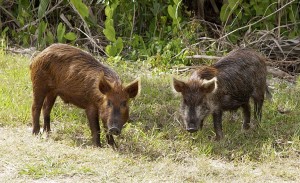Pigs have become synonymous with trouble; not like the troublemaking green pigs in the game Angry Birds, but as brown, tusked creatures that eat and destroy anything in their path. With wild pigs causing an estimated $1.5 billion in damages in the United States, there is a pressing need to find a more effective way of eradicating them. The US Department of Agriculture (USDA) has created a new program with $20 million in funding devoted to getting their numbers back under control.
Wild pigs were first introduced in 1539 by Spanish explorers to Florida as domestic pigs who then later escaped into the wild. Eventually feral populations stabilized, with the largest populations today in the coastal states around the Gulf of Mexico and California. There are an estimated four to five million wild pigs in America: more than the population of Los Angeles.
Because of the wild pigs’ ability to flourish in many different conditions, they are a growing problem, already spreading to over thirty-nine states. They occupy a variety of different habitats and are opportunistic omnivores, eating whatever they can find, including, and not limited to, injured or young livestock, carcasses, nuts, and leaves. Under optimal conditions, female sows can begin breeding at six months old and have up to four litters per year.
The damage that wild pigs cause is also a reason for concern. Classified as an invasive species, wild pigs can impact humans in several ways: first, by spreading diseases such as psuedorabies and tuberculosis to livestock and people. In addition, feral pigs, also known as “rototillers of nature,” destroy fields and fences and create wallows in pastures, causing over $1.5 billion in damages and control costs every year to agriculture. With their tramping and rooting behaviors, they can also damage the natural habitats of threatened or endangered species such as grassland birds, wetland wildlife, small mammals, and fish.
Traditional control techniques include shooting, trapping, and snaring, but these methods, each with their own weaknesses, have not been able to stop overall population growth. Scientists hope to use part of the money provided from the USDA program to investigate new techniques against the wild pigs like using sodium nitrite, which has been traditionally used in Australia as a pig poison.
Much of the $20 million funding will go to state projects, which target problems specific to each state. $1.5 million will be used to improve current control practices and research new ones, like toxicant and fertility control agent use and delivery; another $1.4 million will go to monitoring and controlling disease, through research surveillance and vaccination techniques. A further $1.6 million will be used to centralize and improve the safety of control operations. The ultimate goal of the USDA is to eliminate wild pigs from two states every five years and stabilize the damage they cause within ten years.
As one commenter on a Scientific American article said, there is perhaps another effective way to cull the pig population: “EAT ‘EM!! Delicious!!”

